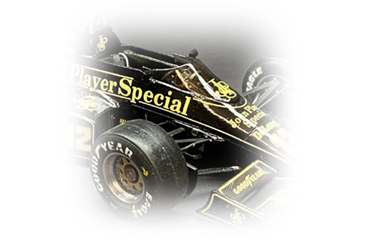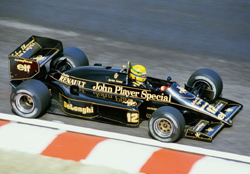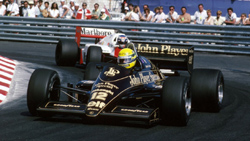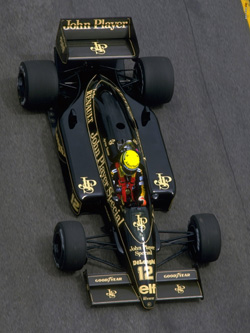The Lotus 98T, designed by Gérard Ducarouge and Martin Ogilvie was Lotus' entry into the 1986 F1 World Championship. A development of the previous year's 97T, the car was raced by Brazilian Ayrton Senna who was in his second season with the team and newcomer Johnny Dumfries from Scotland. Ellio de Angelis had driven for Lotus since 1980 however decided to move to Brabham for the 1986 season. Derek Warwick was originally chosen to replace de Angelis however Senna objected and felt the team could not manage two number one drivers and suggested moving for Mauricio Gugelmin. John Player, the teams main sponsor objected to this and instead Dumfries was signed as the British Tobacco company wanted a British driver in the team, something which was to prove pivotal later.
The chassis featured a lower monocoque than the 97T due to changes in F1 regulations in 1986 which demanded fuel capacity reduced to 195 litres. Powered by the new Renault EF15B turbocharged V6 engine though both a five or six speed Hewland manual gearbox with Senna opting for the five speed box and Dumfries being given the task of testing the new six speed box. Engine power figures for this era in F1 are largely speculative, however it is claimed that the Renault EF15B produced in excess of 1000 HP, if this was true it would make it one of the most powerful engines ever used in the history of Formula 1. The 98T was also the final Lotus powered by a Renault engine, as Lotus switched to Honda for the following season.
Notable innovations of the 98T included a two-stage ride height adjustment, water injection through the intercoolers, an early form of barge board (also present on the 97T), and an advanced (for the time) fuel consumption microcomputer.
The 98T was the last Lotus car to carry John Player's famous black and gold colours. With Renault withdrawing from F1 at the end of 1986, Lotus opted to go with Honda and use the Japanese company's engines in both the 1987 and 1988 seasons. As part of this deal, Satoru Nakajima was signed as Senna's teammate for 1987. John Player, still wanting a British driver in the team, subsequently pulled its sponsorship, to be replaced by Camel.
The build is a curbside model manufactured by the company Club M, extra detals were added to the cockpit area and the transmission (the only element of the engine included) and Carbon Fibre decal added where applicable.
 |
| Click above for build and completed pictures |
|
|
 |
| Ayrton Senna - 1986 Australian GP |
 |
| Ayrton Senna - 1986 Monaco GP |
 |
| Ayrton Senna - 1986 Monaco GP |
|



